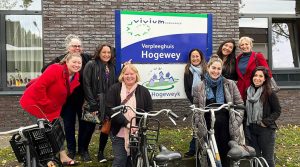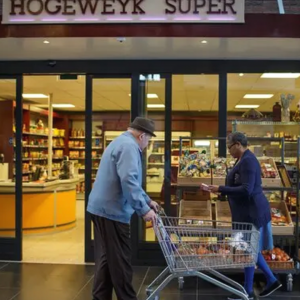- People with Disabilities
- Seniors

Staying on the cutting edge of treatments for people with memory loss and their families is vital for the industry-leading team behind JFCS’ Center for Dementia Care. That’s why, recently, we embarked on a transformative journey to explore what could be the future of Alzheimer’s and dementia care.
Joined by colleagues from Rhoda Goldman Plaza—JFCS’ premier assisted living community—our team traveled to Amsterdam for an exclusive and immersive training experience at the Hogeweyk.
Immersive Training with the Hogeweyk

The Hogeweyk (pronounced HOH-guh-vaik), established in 2009, is a world-famous memory care community that shares JFCS’ specialized, person-centered philosophy of treatment. The treatment center is the recipient of several international awards and media attention for its pioneering therapies that give residents a higher quality of life with more activity and freedom and less medication and restriction.
JFCS’ team is highly trained in successful innovations from around the world, but nothing prepared us for our extraordinary time within this community. Our training at the Hogeweyk revealed the immense benefits that come from putting autonomy at the center of caring for those with advanced dementia.
Here are some of the philosophies that are central to the Hogeweyk’s groundbreaking approach that may be useful to anyone who is caring for a loved one with dementia:
1. Put Autonomy First
At the heart of the training was the Montessori approach to dementia care, encapsulated by Maria Montessori’s principle: “Everything you do for me, you take from me.” This philosophy challenges conventional expectations about memory care communities where the selling points are customer service, luxury, and accommodation. By limiting what an individual must do for themselves, do we also remove autonomy, purpose, and value from their experience? Putting autonomy at the forefront of care turns that idea around and enriches the lives of those with memory loss with purpose.
2. Honor Individual Choices
One observation challenged the team’s preconceptions—a resident walking alone in the cold without a jacket. Instead of immediately intervening, a caregiver approached the resident with a coat ten minutes later. The resident wasn’t made to feel panicked or confused; they expressed gratitude for the gesture and continued to sit beneath a tree on the sidewalk, soon joined by a companion. This approach honored the choices of the resident and ultimately yielded a positive result. Having the freedom to make choices and, yes, mistakes is a critical part of the lived experience.
3. Infuse Vibrancy into Daily Life
Within the village, a coffee shop, a restaurant (open to the public), a grocery store, and a small mall create a dynamic atmosphere of busyness and traffic, bringing life to the area. This sense of liveliness and energy is something people living in memory care communities crave. Routine is important, of course, but can easily turn stale when each day is a quiet, uneventful repeat of the one before—sound and motion bring color to daily life!
 4. Grant Responsibility
4. Grant Responsibility
The village’s grocery store, a highlight for the team, turned out to be so much more than they expected. It isn’t a “pretend” store where money doesn’t matter. Residents actively plan and pay for their groceries, with the help of caregivers. This revelation aligned seamlessly with the principles of autonomy and choice that underpin the Hogeweyk’s philosophy. Something as seemingly mundane as running errands can give adults experiencing memory loss a sense of control over their lives.
5. Embrace the Small Details
The Hogeweyk’s design revolves around connecting residents with “life’s simple pleasures.” The village adapts its physical environment to accommodate residents. The key to this approach is understanding that details matter. For example, residents live in homes with 5-6 others, grouped according to common interests like lifestyle and aesthetic preference. The environment and design are key components to supporting residents with advanced dementia, ensuring they feel comfortable that their needs are being met within the space. Caregivers also wear regular clothing that’s suited to the environment in which the resident is most comfortable—rather than be dressed as a nurse or orderly, they might dress more like a neighbor or even a domestic servant. These details go a long way towards helping residents live their lives authentically as individuals.
6. Preserve Lifelong Skills and Hobbies
A commitment to preserving lifelong skills sets the Hogeweyk apart. The staff recognizes that people with dementia can continue to use and develop skills rather than assuming they would lose those abilities over time. Residents engage in stimulating activities like meal prep and shopping, as well as enjoy the many amenities throughout the village—a theater, a fountain, plenty of art and sculpture. Maintaining favorite routines and hobbies stimulates cognitive function and opens the door to learning new ones.
Our Dementia Care at JFCS
The Hogeweyk’s philosophies of autonomy and enrichment are also central to our approach at JFCS’ Center for Dementia Care. By integrating our learnings from our visit to Amsterdam into our practices, we will continue to foster an environment where individuals with dementia here in our own community can thrive with dignity, purpose, and joy.
JFCS’ Center for Dementia Care provides specialized support for people experiencing Alzheimer’s or dementia, as well as practical and emotional support for their families. Our approach to dementia care centers on the strengths and abilities of each individual in our care.
To learn more about dementia care, visit JFCS’ Seniors At Home or call 877-754-1774 for a consultation.
